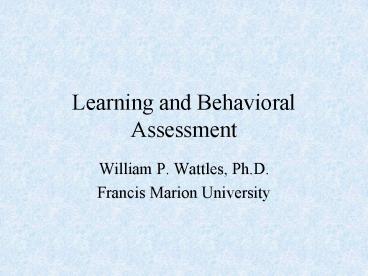Learning and Behavioral Assessment - PowerPoint PPT Presentation
1 / 44
Title:
Learning and Behavioral Assessment
Description:
The study of observable behavior with an emphasis on the ... called the discriminative stimulus. Behavior. Behavior or response. Something the organism can do. ... – PowerPoint PPT presentation
Number of Views:26
Avg rating:3.0/5.0
Title: Learning and Behavioral Assessment
1
Learning and Behavioral Assessment
- William P. Wattles, Ph.D.
- Francis Marion University
2
What is learning?
- How organisms come to behave in new ways.
- motivation
- knowledge
- change in behavior
3
Behaviorism
- The study of observable behavior with an emphasis
on the role of environment in determining
behavior in terms of operant and classical
conditioning.
4
Stimulus
- a property of the environment that you can detect
with your senses.
5
Response (Behavior)
- Something you do.
6
- What is this couple not doing?
- Are they not reading?
- Or are they not sleeping?
- Not doing something is not a behavior.
7
Response
- Something you do. Also called behavior
- Response Behavior
- Behavior can be
- elicited
- emitted
8
Elicited Behavior
- A behavior such as a reflex that results from the
presentation of a stimulus and is not voluntary. - Example Patellar reflex
9
Emitted Behavior
- A voluntary behavior. The organism may or may
not make this response.
10
Classical Conditioning
- Pavlovs Dog
- Meat powder
- Salivation
- Metronome
- Salivation
11
CS
elicits
conditioned stimulus
metronome
CR
conditioned stimulus
salivation
elicits
US
UR
Unconditioned stimulus
unconditioned response
salivation
meat powder
12
Classical Conditioning
- The dog learns to associate meat powder with the
metronome. - The dog learns pairing
- the dog learns what goes with what.
13
Operant Conditioning
- Thorndikes cat
- cage
- food
- pulling the rope
- getting the food
14
Antecedent
- a stimulus that tells or reminds the organism
about a relationship between a behavior and
another stimulus - called the discriminative stimulus
15
Behavior
- Behavior or response. Something the organism can
do.
16
Consequence
- A stimulus or property of the environment that is
presented contingent on the behavior.
17
Antecedent
Behavior
Consequence
18
Contingent
- The consequence is contingent on the behavior. No
behavior no consequence.
19
Contingent
- The consequence is contingent on the behavior. No
behavior no consequence.
20
Operant Conditioning
- The cat learns the consequences of its actions.
- The cat learns what to do to get what you want.
21
Operant conditioning
22
Positive reinforcement
- Antecedent
- Response
- Consequence
- What happens to the behavior?
23
Response Cost
- Antecedent
- Response
- Consequence
- What happens to the behavior?
24
Negative reinforcement
- Antecedent
- Response
- Consequence
- What happens to the behavior?
25
Punishment
- Antecedent
- Response
- Consequence
- What happens to the behavior?
26
Three requirements for reinforcement
- The behavior must increase
- The consequence must be contingent on the
behavior - The contingency must cause the increase in
behavior.
27
Extinction
- When reinforcers are no longer provided, the
behavior stops
28
Extinction Burst
- When you begin to stop delivering a
- reinforcer, the behavior first increases
- before it decreases to zero.
29
- Partial Reinforcement Schedules
- Intermittent reinforcement schedules take
- longer to extinguish.
30
Continuous Reinforcement (CRF)
- is the first and most basic of the Schedules.
Under this schedule, every time the target
behavior occurs, it is reinforced. The ratio of
reinforcement to behavior is then 11.
31
Fixed Schedules of reinforcement
- are an extension of the CRF concept. Instead of
one reinforcement for each behavior, a
predetermined number of behaviors are required to
earn reinforcer. - A Fixed Ratio of 31 then would mean that the
individual would have to demonstrate the target
behavior 3 times in order to receive a
reinforcement.
32
Variable Schedules of reinforcement
- are the ultimate goal of any intervention. A
Variable Ratio Schedule of 31 means that on the
average the person is reinforced for every 3
demonstrations of the target behavior.
33
Ratio Strain.
- This happens when the Schedule of Reinforcement
is set too high and the individual "gives up"
before the next reinforcement becomes available.
34
stimulus generalization
- Reinforcements will generalize across similar
stimuli producing secondary conditioning
35
What Is Behavior Analysis?
- Direct measurement of behavior through systematic
observation and recording systems.. - Functional analysis of the causes of behavior
find factors that prompt and maintain the
behavior of interest. - An emphasis on using positive reinforcement to
build and maintain desirable behavior.
36
Functional Analysis
- Antecedent
- Behavior clearly specified and measurable
- Consequences (maintaining variable)
37
(No Transcript)
38
Functional Analysis
- In the field of applied behavior analysis. This
is the process of determining the cause (or
"function") of behavior before developing an
intervention.
39
Methods to determine function
- interviews and rating scales,
- direct and systematic observation of the person's
behavior, and - manipulating different environmental events to
see how behavior changes.
40
Types of behavior
- a) behavior that produces attention and other
desired events (e.g., access to toys, desired
activities), (b) behavior that allows the person
to avoid or escape demands or other undesired
events/activities, and (c) behavior that occurs
because of its sensory consequences (relieves
pain, feels good, etc.).
41
Competing Response
- Differential Reinforcement of Other
- Reinforce a competing response to decrease a
behavior.
42
Response prevention
- Escape or avoidance conditioning.
43
Catch em being good.
- Benefits of reinforcement over punishment.
- Energy
- Self-image
- Feelings toward teacher
- Mood
- Potential for abuse
44
- The End
The End































